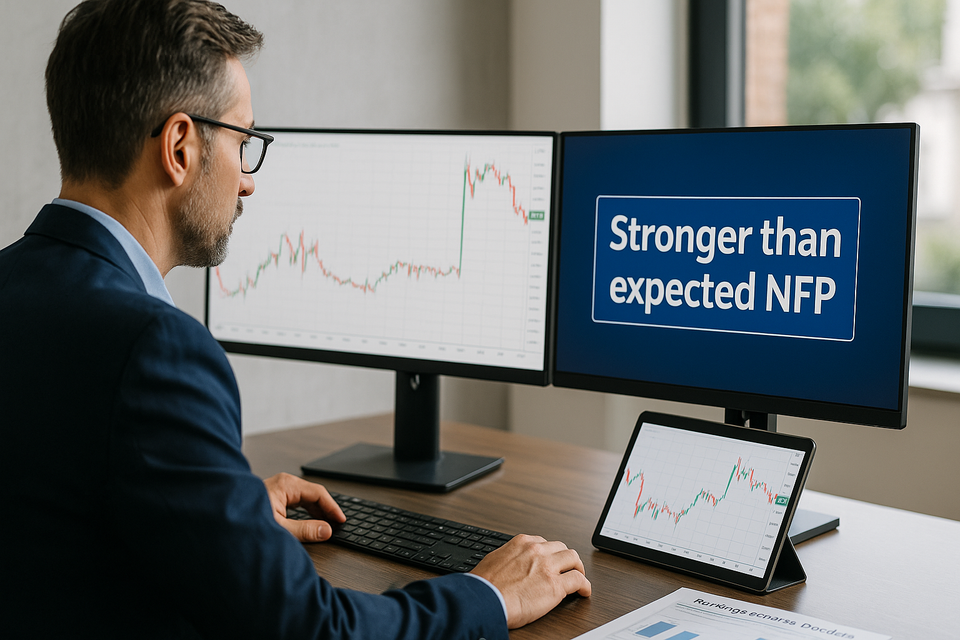When One Jobs Report Moves the World

How currency shifts ripple through your portfolio—often in ways you don’t see
The Jolt Beneath the Surface
A single jobs report just shifted the tone of the market.
The U.S. economy added 147,000 jobs in June—well above forecasts of 110,000.
The unemployment rate dipped to 4.1%, and wages grew 3.7% year over year.
Within minutes, the U.S. dollar surged, bond yields jumped, and investors recalibrated their expectations.
Just like that, a shift in one number reset the tone for portfolios everywhere.
And whether you noticed or not—it touched yours too.
What Just Happened
The U.S. Dollar Index (DXY) had been falling for months—down more than 10% year to date, its worst first-half performance since 1973.
Markets were pricing in political uncertainty, rate cuts, and better prospects overseas.
But strong jobs data sent a different message.
Suddenly, the dollar rebounded.
USD/JPY, EUR/USD, and other major pairs flipped direction.
Gold lost ground. Emerging market assets wobbled.
And international investors were reminded of something critical:
Currencies don’t just reflect economies—they shape your outcomes.
What This Reveals
Most of us track our investments in price charts.
But behind those price moves, currency shifts are constantly at work.
They can quietly enhance—or erode—your returns.
A stronger dollar hurts foreign revenue for U.S. companies.
It reduces the USD value of unhedged global ETFs.
And it can turn strong local-market performance into weak dollar returns.
This is why even one jobs report can ripple through everything you hold.
What You Can Do About It
Currency moves don’t just show up in forex trades.
They quietly reshape your returns—especially when you invest globally.
Here’s how to build in more awareness, without overcomplicating your process:
Review your international exposure
- Funds like Vanguard FTSE All-World ex-US (VEU) are unhedged—returns can dip when the dollar rises.
- U.S. multinationals like Apple (AAPL) earn about 57% of revenue abroad—so currency shifts directly hit earnings.
Think in relative terms
- Currencies move in pairs—it’s not just about USD, but what it's rising or falling against.
- If the yen weakens and the dollar strengthens, funds like iShares MSCI Japan (EWJ) may underperform—even if local stocks rally.
Use FX-aware tools
- Platforms like Koyfin or Morningstar help you track currency-adjusted performance.
- A small FX drag can quietly flatten a strong position—so don’t just look at price alone.
Watch central bank divergence
- The Fed is holding, but ECB and BOJ are easing. That spread can drive dollar volatility.
- If you own EM debt like iShares EMB, you’re not just taking credit risk—you’re exposed to local currency swings too.
Consider hedging selectively
- iShares Currency Hedged MSCI EAFE (HEFA) offers the same stocks as EFA, but strips out FX risk.
- In 2025, HEFA returned ~8% vs EFA’s 17%—but in strong dollar years, it’s often the reverse.
A Question to Sit With
Are your investments riding quiet tailwinds—or hidden headwinds?
You Don’t Need to Predict the Next Print
Currency moves aren’t loud.
They don’t flash on the screen.
But they show up in your performance—often when you least expect it.
You don’t have to react to every data point.
But you do need to know which ones ripple through your portfolio.
Because you're not just investing in companies.
You're investing across currencies—whether you realize it or not.
Strategies Worth Watching
Smarter Orders, Stronger Execution

Placing a trade is easy.
Placing it the right way is what separates new investors from prepared ones.
Most beginners only use market orders—and that’s where mistakes begin.
The reality? Understanding just a few core order types can meaningfully improve your results.
This short video tutorial walks through 10 essential order types every investor should know in 2025.
It’s quick. It’s clear. And it’s something most trading platforms don’t teach well.
You’ll learn how to:
✅ Use stop-loss and trailing-stop orders to limit downside
✅ Protect gains with bracket orders
✅ Set smarter entries using limit and stop-limit orders
✅ Avoid overpaying or panic-selling in volatile moments
If this feels like one of your knowledge gaps—this is your chance to fix it fast.
🎥 Watch the 10 Order Types Tutorial on YouTube
Want to go deeper than just trade mechanics?
The Super Investor Club gives you hands-on frameworks and strategies built around real portfolio growth—not just screen time.
🔗 Start your free 2-week trial here
P.S. It’s commitment-free. Cancel anytime. But the lessons could stick with you for years.
More Tools for Your Journey
Find the Strategy That Suits You

You’re ready to invest—but not sure where to start.
Growth? Income? Index funds? Active picks?
It’s easy to feel overwhelmed by options that all sound smart.
Curated newsletters help filter the noise and clarify what fits your goals.
They walk through different strategies with real examples, not jargon.
You’ll gain confidence not just in what you’re doing—but why you’re doing it.
If you’re still figuring out your style, this shortlist might help.